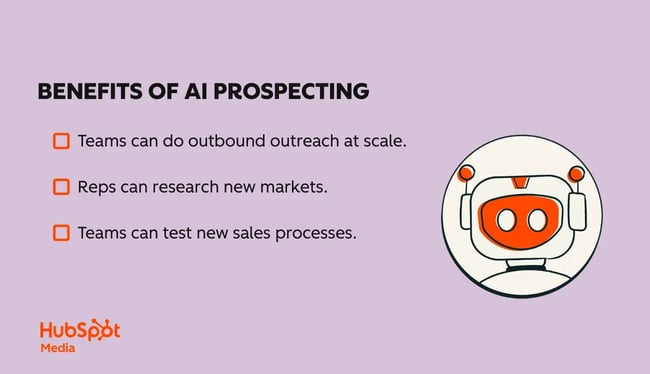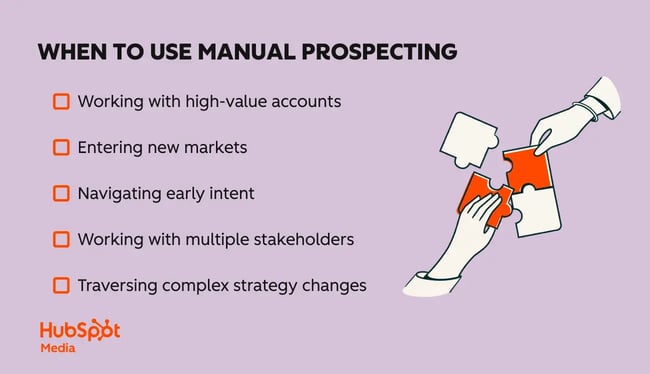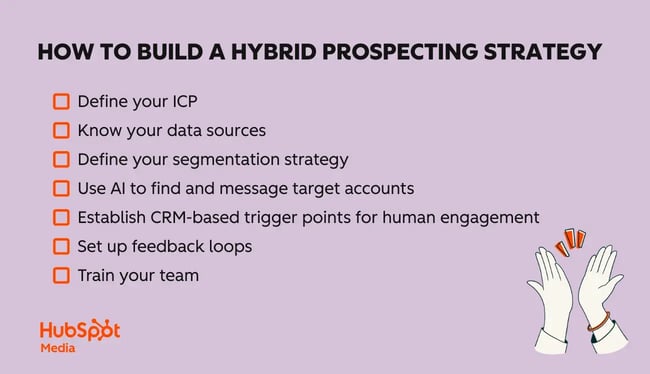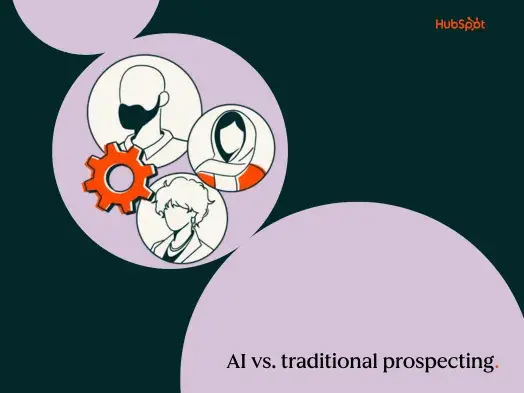In the age of AI, sales organizations face a fundamental shift in how prospecting gets done. Artificial intelligence can now handle repetitive tasks that once consumed entire workdays. Reps can partner with AI to research leads and craft the right messages, so they can focus on fostering connection.
Savvy sales teams strike the right balance, knowing when AI beats manual outreach and when prospects need the human touch. AI-powered sales agents like HubSpot Breeze can help teams build the right hybrid approach.
This post explores the advantages of AI-driven prospecting, where manual outreach still wins, and how to combine both approaches.
Table of Contents
- AI vs Traditional Prospecting: The Decision You’re Making
- How to Build a Hybrid Prospecting Strategy
- Prospecting: What to Automate with AI vs. Traditional Prospecting
- Frequently Asked Questions about AI vs. Traditional Prospecting
AI vs Traditional Prospecting: The Decision You’re Making
Sales leaders currently navigate three distinct paths: full automation, human-first engagement, or a hybrid model that combines both. Each approach carries distinct advantages and risks. Here are the benefits of AI vs. traditional prospecting.
When AI Prospecting Wins
AI prospecting automates research, lead scoring, and first-touch outreach. In fact, AI tools can help teams understand intent signals and find prospects who match their ICP. With the ability to operate at scale, AI agents like Breeze can help teams sell at scale.
Unlike generic automation tools, Breeze is trained to think like a sales partner. It continuously refines targeting, adapts sequences based on engagement data, and learns from rep feedback. That means your AI prospecting model doesn’t just run campaigns — it gets smarter with every conversation.
Here are other AI prospecting benefits.

Outbound at Scale
AI-driven systems can prospect at a scale humans can’t match. In the past, reps would have to research each prospect individually, digging into LinkedIn profiles and company updates. AI agents can crawl thousands of prospect records in minutes and surface behavioral signals at scale. With an AI agent like Breeze, sales teams know which prospects are most likely to buy.
Once AI tools determine who to target, automated sequencing ensures no lead falls through the gaps. Outreach workflows run automatically.
So for teams that rely on a high volume of outreach for a high volume of sales, AI prospecting is a valuable solution.
I’ve personally used AI tools to surface hundreds of net-new accounts in minutes. I could find prospects that fit my ICP but hadn’t been touched by marketing or other reps. That’s something that would’ve taken days of manual research. In that context, AI isn’t just helpful: it’s a force multiplier.
When Researching New Markets
It’s also incredibly effective for exploring adjacent markets. Let’s say a company has historically focused on B2B SaaS in New York. AI can help the team test the waters in fintech across the Midwest. AI can create directional maps quickly. With this information, reps can see what companies look like top accounts but exist in new territory.
I’ve seen this capability in action. I’ve used AI to help companies scale into new verticals, especially when time-to-pipeline mattered more than perfection.
With Breeze, sales teams can automate prospect research. Breeze analyzes multiple data sources to identify when prospects are most likely to engage, allowing reps to scale engagement without sacrificing relevance.
Testing New Sales Tactics
Reps should also use AI for testing and iteration. Want to validate a new messaging angle or outbound sequence? Run it against a batch of AI-sourced leads. If it gets traction, go deeper. If not, pivot fast. That experimentation loop is where AI truly shines. It allows sales teams to move faster without burning out.
Pro tip: New reps are experimenting constantly as they find their groove. AI is especially valuable for junior reps who are still developing their outbound instincts. AI acts as a partner and gives them a baseline to work from.
When Manual Outreach Wins
When reps treat AI outputs as plug-and-play, the model starts surfacing only what it knows. Teams see the same lookalike accounts, with the same titles, in the same cities. That’s where manual outreach comes in.
Manual prospecting relies on human judgment and personal connection. When deals depend on relationships, subtle buying signals, or identifying early-stage intent, human reps shine.

For High Value Accounts
There are moments in sales when reps don’t need speed: they need instinct. That’s when human-led prospecting becomes essential. Reps should lean into manual outreach when nuance, context, and judgment matter more than scale.
While AI can find patterns, it can’t feel urgency. And it definitely can’t build trust the way a curious, emotionally attuned seller can. Adding the human touch and fostering relationships is especially important for high-value accounts.
I’ve seen AI prospecting models miss golden opportunities simply because the data didn’t match its expected mold.
For example, I once closed a $200K deal with a bootstrapped logistics firm that didn’t have any of the “signals” the model was looking for. But, I caught a comment in a niche LinkedIn thread where the COO hinted at needing a data integration partner. That lead would’ve never been surfaced by automation. It took human curiosity to see the signal in the noise.
When Entering New Markets
AI can help teams research new markets. But, humans should pilot the strategy when entering these new fields.
Reps should default to human-led prospecting when entering emerging markets or new ICP segments. AI tools are only as smart as the data they’re trained on. If there’s no historical footprint for that segment in a team’s CRM, the model can’t start prospecting.
Traditional prospecting lets teams learn directly from the field: how buyers talk, what triggers matter, and who the unexpected influencers are. That’s invaluable context, especially in new territories.
I’ve helped teams break into markets like LATAM and APAC, where manual outreach was necessary.
When Navigating Early Intent
When reps are dealing with early intent, humans should take the lead. AI tools often rely on clear, trackable signals, like firmographic changes or job postings. But, for early intent, real buying signals often show up in softer places. That may include:
- An executive asking a question in a Slack community.
- A founder commenting on a Gartner trend.
- A revenue leader quietly follows your company page.
These are the moments when human intuition can detect a door slightly cracked open and act fast. AI is great at finding people ready to buy, and human reps are great at warming up people ready to talk.
For Deals with Multiple Stakeholders
Human-led prospecting plays a critical role in breaking into complex organizations with multiple stakeholders. AI might give reps one contact, maybe two. But AI won’t map internal power dynamics. It can’t tell you who’s influencing the budget behind the scenes or what departments have friction.
I’ve spent entire days reverse-engineering org charts on LinkedIn and using second-degree connections to build whisper networks. Those efforts have directly led to multi-threaded, enterprise deals that AI simply couldn’t penetrate.
Complex Strategy Changes
Finally, human-led prospecting is essential for teams making strategic shifts. If companies are entering a competitive space, rebranding, or repositioning, they can’t rely on pre-trained models to carry the message.
Teams need people out there talking, reframing objections, delivering new narratives in real-time. In this sense, human-led outreach becomes not just a pipeline driver but a brand builder.
So when the deal is complex, the buyer is skeptical, or the market is undefined, bring in the human. That’s where experience, empathy, and creative outreach win every time.
Capability | AI Prospecting | Traditional Prospecting | Hybrid Prospecting |
Scale & Volume | Handles thousands of prospects simultaneously with consistent quality | Limited by human capacity | Combines AI volume for broad reach with human focus on high-value targets |
Personalization Depth | Surface-level personalization using data fields and templates | Deep personalization based on research, intuition, and contextual understanding | AI drafts personalized content; humans refine for critical accounts |
Trust Building | Lower trust signals; prospects recognize automation | Strongest trust-building through authentic human interaction | Trust scales through human engagement at critical moments |
Response to Objections | Limited to pre-programmed responses; lacks adaptability | Real-time objection handling with contextual awareness | AI surfaces common objections; humans handle complex negotiations |
Consistency | Perfect consistency in timing, messaging, and follow-up | Variable quality based on rep workload and discipline | Consistent automation foundation with human excellence where it matters |
Pipeline Velocity | Fast pipeline filling but potentially lower conversion rates | Slower pipeline building with higher conversion quality | High volume entry with strong conversion on priority deals |
How to Build a Hybrid Prospecting Strategy
The AI vs traditional prospecting debate is over. It’s not either-or. Teams need to know when to deploy each. AI is a scalpel: it makes clean, repeatable cuts. Human-led prospecting is the hand that knows when to pause, shift angles, or feel for resistance.
Hybrid prospecting combines AI automation with human-led engagement. Teams that partner with Breeze can make the most of this hybrid approach.
When building an AI prospecting strategy, I always start from the same premise: don’t build it in a vacuum. A good AI strategy isn’t just about plugging in filters and hoping for a flood of leads. It’s about aligning machine learning with human learning. And that means treating your AI system like a high-potential SDR: it needs training, feedback, guardrails, and coaching.
Here’s a framework that can help teams get started.

Define your ICP.
When building a hybrid strategy, teams should establish a clear ideal customer profile (ICP). Knowing who to target can help determine which prospects should be engaged with an AI tool versus those who still need the human touch.
Too often, I see teams feed their AI tools outdated or overly broad targeting criteria, then wonder why the leads are off. I always ask:
- Who are your fastest-moving deals?
- Who champions you internally?
- What do your closed-lost accounts have in common?
That insight should guide your inputs. And your model should be trained on current pipeline intelligence, not just historic wins that are no longer relevant.
Know your data sources.
Next, teams need to choose their data sources carefully. Many AI tools lean heavily on LinkedIn, Crunchbase, or internal CRM records, which are useful but often biased. If a CRM has gaps or past sales activity leans toward one sector, AI prospecting will carry that bias forward. That’s the danger of unexamined data: AI learns what you’ve done, not what’s possible.
I once worked with a team whose AI model ignored public sector leads entirely, not because they weren’t valuable, but because no one had ever closed one before. That’s why I recommend layering in multiple datasets.
Bring in enrichment tools, scrape job boards, monitor hiring trends, and use social listening. The more diverse the input, the more balanced the AI prospecting model becomes. And teams start to build a system that surfaces opportunity, not just familiarity.
Define your segmentation strategy.
Then comes segmentation strategy. AI prospecting shouldn’t be one-size-fits-all. Teams should build separate workflows for different tiers of accounts.
Let AI surface leads at scale for mid-market or expansion motions, where personalization can be templated. But for enterprise and high-ACV deals, use AI as a signal booster, not the final decision-maker. Let the model suggest targets, then let reps do what they do best: dig deeper, triangulate insights, and personalize with intention.
One technique I use consistently is what I call the “Human-Check Layer.” Before any AI-generated list goes live, I run it past either a rep or a strategist to gut-check for obvious gaps or biases. You’d be surprised how many brilliant-looking lists are 80% filler once you filter out accounts that are too small, too big, or completely misaligned with your product’s value prop.
AI can generate speed, but you still need humans to make it strategic.
Use AI prospecting tools to find and message target accounts.
With the right infrastructure in place, teams can leverage AI-powered prospecting platforms to build target account lists. Breeze Intelligence allows teams to automatically discover companies matching specific firmographic attributes. That includes targeting prospects based on:
- Industry.
- Size.
- Technology stack.
- Growth indicators.
- And geographic location.
This automated discovery process typically identifies more qualified accounts than manual research methods. Beyond that, AI makes the process faster. Building a list can take days to do manually. Now, large lists can be made in hours.
Some businesses may then use AI to send initial outreach messages to certain segments. While high-value and complex accounts may require the human touch, Breeze can allow reps to send out reach messages strategically at scale.
Establish CRM-based trigger points for human engagement.
In hybrid workflows, AI can surface prospects and initially do the outreach. From there, humans step in. Hybrid workflows depend on clear signals that determine when prospects transition from automated sequences to human attention. AI tools integrate with CRM systems for unified data and compliance. That integration makes the transition seamless.
Common triggers include:
- Prospect replies to AI-generated outreach.
- Engagement scores exceeding defined thresholds.
- Deal values surpassing certain amounts.
- Or accounts matching ideal customer profile criteria.
HubSpot’s Smart CRM and Breeze AI Suite enable operationalizing hybrid prospecting strategies. The CRM systems can automatically route these prospects to appropriate sales representatives and pause AI-driven sequences. Once the hybrid plan is in place, teams can then manage outreach sequences, tasks, and execution in Sales Hub.
Set up feedback loops.
AI prospecting requires feedback loops. In fact, a team’s AI strategy should evolve based on what’s working in the field. If reps are ignoring suggested leads, that’s not a behavior problem: it’s a data problem. Sales teams should track conversion rates, meeting quality, and capacity metrics. That can help identify areas for improvement.
Build mechanisms for reps to rate lead quality, flag misalignments, and highlight wins that came from outside the model. That’s how teams improve accuracy over time, and it’s also how they avoid the trap of reinforcing bias in AI prospecting models through passive data.
Train your team.
Finally, train the team on AI prospecting best practices. Teams should focus not just on the what. They also need to know the why. If reps don’t understand how the model works, what it’s optimizing for, or how to course-correct it, they’ll either overtrust it or ignore it. Both are dangerous.
I’ve led AI onboarding sessions where the most valuable moment wasn’t the tool walkthrough; it was the open discussion about where AI shines and where it falls short. That transparency builds trust. And trust builds adoption.
To me, the best AI prospecting strategy is one that’s modular, iterative, and human-aware. You need systems that scale, but you also need judgment at every step. This isn’t AI vs. traditional prospecting. It’s AI with traditional prospecting, each making the other sharper.
Because at the end of the day, AI can generate a list. But only humans can build a relationship. And no matter how advanced the model is, it’s still your voice, your empathy, and your insight that wins the deal.
Prospecting: What to Automate with AI vs Traditional Prospecting
Effective hybrid prospecting requires teams to know what tasks need human oversight. The following framework can help teams decide what tasks should go to human reps and which are best left to AI.
Prospect Discovery and Research
AI systems should handle the majority of initial research activities. These data collection and processing tasks leverage AI’s speed and scale advantages while requiring minimal judgment. That includes:
- Identifying target companies.
- Finding key contacts.
- Gathering firmographic data.
- And scanning for trigger events.
Sales representatives should focus their time on understanding strategic context. Competitive positioning, organizational priorities, and relationship networks all require a human touch.
Breeze prospecting agent can handle this research workload automatically. Once a rep enrolls target companies, the agent continuously monitors for buying signals and researches prospects across multiple sources. This automated research capability means reps can focus their energy on strategic context rather than data gathering.
Lead Scoring and Prioritization
Predictive lead scoring is one of AI’s strongest prospecting use cases. Machine learning models can analyze hundreds of variables across demographic and behavioral data to see which accounts are most likely to convert. Breeze AI Suite delivers AI insights that help teams prioritize accounts based on propensity to buy, optimal contact timing, and channel preferences.
Beyond that, Sales Hub includes predictive lead scoring. The tool uses machine learning to determine the probability that open contacts will close within 90 days. These properties help sales teams prioritize outreach efforts based on data-driven predictions rather than gut instinct alone.
Sales representatives should review AI scoring outputs regularly to validate that outputs match strategic priorities. Even if some accounts score low on predictive models, human reps can make sure prospects with partnership potential, market influence, or long-term value still receive outreach.
Personalization and Drafting
AI excels at generating initial message drafts that incorporate prospect-specific details, like a company name or recent news. These systems produce coherent outreach content at scale and fast. However, humans should:
- Refine AI-generated drafts to ensure accuracy.
- Adjust tone to match brand voice.
- And verify that value propositions align with actual product capabilities. Sa
Breeze prospecting agent can generate personalized email drafts at scale, incorporating context from HubSpot’s CRM and customizable messaging guidelines.
First-Touch vs Multi-Threading
AI-driven sequences work effectively for initial prospecting touches where the goal is broad reach and response generation. Automated systems can manage first and second touches—introduction emails, follow-up messages, and value-based nurture content—that require minimal customization. However, once prospects respond or multiple stakeholders require engagement, human orchestration becomes essential. Sales representatives must coordinate multi-threaded outreach that cultivates relationships across buying committees, adjusts messaging for each stakeholder’s priorities, and manages timing to avoid overwhelming accounts.
The transition point should be explicit: AI owns cold outreach and initial response generation; humans take control when conversations begin or when account strategy requires coordinated engagement across multiple contacts. CRM workflows should automate this handoff based on reply detection and account status changes.
Follow-Up and Meeting Prep
AI systems should handle routine follow-up tasks, like:
- Sending meeting reminders.
- Sharing recap summaries.
- Delivering promised resources.
- And re-engaging dormant prospects.
Breeze prospecting agent can automate these routine follow-up activities while maintaining personalization.
However, humans should manage follow-up for active opportunities, high-value accounts, or situations requiring judgment about next steps.
Meeting preparation is a collaborative task. AI can generate briefings that sales reps can review and enhance with strategic context. This division ensures reps enter conversations fully prepared, while avoiding the time cost of manual research compilation.
Frequently Asked Questions about AI vs Traditional Prospecting
Before you start building your hybrid strategy, here are a few common questions teams ask when implementing AI prospecting tools.
What’s the best way to integrate AI prospecting tools with our CRM?
Effective integration requires data to sync between prospecting tools and the CRM. AI tools should be able to access CRM prospect records while logging research findings back into the CRM system.
Breeze prospecting agent integrates natively with HubSpot’s Smart CRM, automatically syncing data directly into contact and company records. This native integration means buying signals detected by the agent flow into the CRM automatically.
What KPIs should I track to measure the success of AI prospecting?
Organizations should monitor:
- Contacts reached per sales representative.
- Time saved per rep per week.
- Cost per qualified lead.
- Contact-to-response rate.
- Response-to-meeting rate.
- Meeting-to-opportunity conversion.
- And opportunity-to-closed-won percentage.
Teams should also track pipeline velocity and average deal size to ensure AI prospecting generates quality opportunities. Sales Hub reporting dashboards provide unified visibility into these metrics across both AI-driven and human-led activities. That visibility allows teams to compare performance and determine what tactics deliver results.
How should we handle personalization with AI without risking brand trust?
Organizations must implement mandatory human review for all AI-generated outreach before it reaches prospects, particularly during early implementation phases. Sales reps should verify that AI personalization references accurate information and makes accurate claims about product fit or value delivery.
As confidence in AI output quality grows, organizations can selectively reduce review requirements for low-risk prospect segments. Teams should always maintain oversight for high-value or complex accounts.
When should we pause AI and switch to manual prospecting?
Teams should pause AI-driven sequences and shift to human-led outreach when prospects:
- Indicate serious buying interest.
- Express concerns about previous communications.
- Request detailed product information.
- Mention active evaluations involving competitors.
- Experience sensitive events, like acquisitions, leadership changes, funding rounds, or market disruptions.
CRM systems should enable easy sequence pausing with automatic notifications to assigned representatives when these conditions occur.
How do we prevent our team from over-automating prospecting?
Organizations should establish clear automation boundaries. Internal policies should note what types of accounts must receive human engagement. Additionally, leaders should note automation creep, or when accounts that should receive a human touch are handled solely by AI. These guardrails help teams see where AI usage expands beyond appropriate boundaries.
AI vs Human Prospecting — Hybrid Approaches Win
AI prospecting uses automation to scale outreach. Meanwhile, traditional prospecting relies on human judgment and connection. AI works best for high-volume, repeatable tasks. The manual approach wins for complex deals, executive outreach, and regulated industries where trust wins. The most effective approach blends these approaches.
For best results, train your team, monitor outcomes, and adjust your mix as your data matures. Ready to see how AI and human prospecting can work together? Start free or request a demo to see how HubSpot’s Smart CRM and Breeze AI Suite help your team scale without losing the human touch.
![]()

![Download Now: The State of AI in Sales [2024 Report]](https://no-cache.hubspot.com/cta/default/53/6f674af4-3116-43b0-8a54-4a64f926afb6.png)